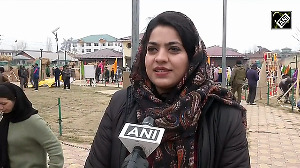The Centre promptly declared that bird flu had hit Indian shores and the disaster-monitoring cell swung into action. A somewhat stunned state government reluctantly fell into step. By Friday night, the National Institute of Communicable Diseases had sent a rapid response team to the state, and dozens of teams of epidemiologists, microbiologists and clinicians were already in the target area.
Navapur poultry farmers cry foul
By Monday morning, over a million birds had been culled, poultry consignments in transit all over the state were being checked before entry into consumer distribution networks, the Centre had despatched additional doses of Tamiflu (Oseltamivir), the most potent available drug for human victims of the virus that can reduce the severity of the illness, and had ready isolation wards in hospitals in the area and also in more distant Mumbai.
In three days flat, the machinery and processes for protecting a population from possible infection from a deadly virus was almost fully in place. That the ordinarily lethargic public health and related machinery of the government could move so briskly tells you a story that is often not obvious. Let's first look at the specific factors that made this possible.
First, the world-wide bird flu alert has been in place for over two years and the response machinery has been well-detailed. Second, the medical and public health community, especially in developed countries, put considerable pressure on World Health Organisation to ask local governments everywhere to be extremely cautious and act quickly. Third, in the current context of international trade and traffic, there is no such thing any more as an "isolated case" of any infectious disease. Fourth, there is no dearth of financial resources to put this huge containment exercise into place; a ministry official is reported to have assured the press that "money is no constraint". Fifth, drug companies, even though cribbing about the state's lackadaisical response in the past to licensing requests for manufacture of the drug, have swung into operation to build stocks in case the virus spreads to human populations. Sixth, going by reports, there was a stunningly smooth and efficient coordination among multiple departments of the government - animal husbandry, public health, environment, commerce, and pharmaceuticals. And seventh, all of this was made possible by a factor elusive in health sector initiatives, "political will."
Interestingly, the government has responded in a similar manner once earlier in recent times. The Surat plague produced an equally efficient, though more limited and short-lived response, and without the supportive global preparedness so evident in the case of bird flu. In the ensuing weeks and months, questions were raised about the nature of the 'plague' - Was it plague at all? Did the government act in haste? But act it had, and quite promptly too.
Will you keep off chicken and eggs? Tell us
Even though the nature of the current health emergency is better investigated than it had been for the Surat incident, there will be many questions on the rationale of the state to take the measures it did. Has the state pressed the panic button when it need not have? Was it prompted by reasons other than the health of the vulnerable population? One spokesperson for the poultry industry has already spied a 'drug MNC' hand in all this. And the local economy of Navapur, entirely dependent on poultry - a concentration of 1 lakh birds per square kilometre - is in a shambles.
The important fact, however, is this - clearly, the government has the entire wherewithal to respond effectively to health emergencies. The sticking point is how a health emergency is defined. Why for instance, does the government not define the rapid spread of malaria under way as a health emergency when it is affecting (and killing) a far larger population than will bird flu? Why do budgetary allocations for the national programme for control remain more or less static for so many years - and ever so often remain unspent? Why don't the several departments - public health, environment, urban development, rural industry, pharmaceuticals - act in consonance to control malaria? Why does the government respond to the continuing spread of leprosy that may also be defined as a health emergency considering that it renders patients unemployable and most often outside the pale of society by knowingly underplaying the numbers?
Flu: Govt ignored warning, say drug cos
Should we then echo the classic formulation that the state responds best to those issues that affect its class interests? The bird flu emergency is a case in point. After all, it impinges on commerce and trade and a small sacrifice of Navapur may "save" the rest of the industry from being tabooed. Even more importantly, it provides an opportunity for showcasing India's ability to deal with national emergencies.







 © 2025
© 2025